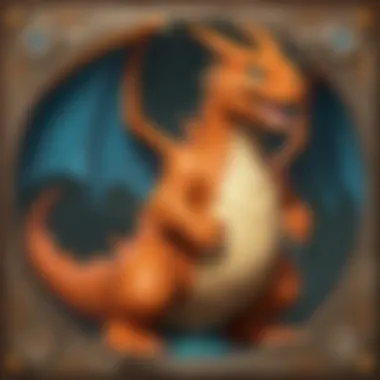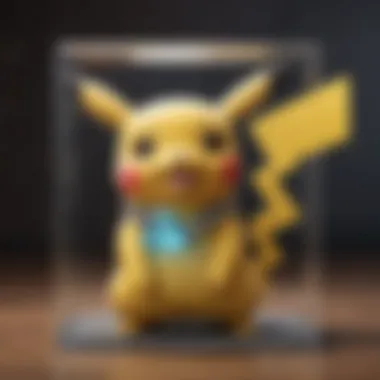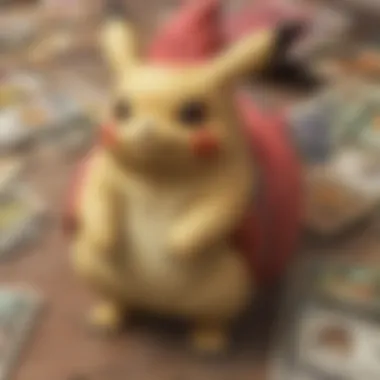Exploring the Value of Rare Pokemon Cards


Intro
The world of Pokémon card collecting has transformed significantly since its inception. What once began as a simple game for children has evolved into a complex marketplace with collectibles worth hundreds of thousands of dollars. This article delves into the intricacies of the Pokémon card market, investigating the factors that determine value, notable examples, and surrounding market dynamics.
In this exploration, we will discuss vital elements such as the historical significance of certain cards, rarity markers, changing collector interests, and the condition of cards. Collectors need to understand these factors to navigate the evolving landscape effectively and make informed decisions about their collections.
Pokemon Game Overview
History of Pokemon games
Pokémon was introduced to the world in 1996, originally as a video game on the Game Boy platform. Since then, it has expanded into various forms of media, including trading card games, anime series, and feature films. The trading card game was first released in 1996, coinciding with the video game's success. The initial base set was a defining moment in the Pokémon franchise and set the stage for the collectible card game phenomenon. The Pokémon Company has since issued numerous expansions and revisions, allowing collectors to engage with different sets over time.
Evolution of gameplay mechanics
The Pokémon card game mechanics have undergone several updates and changes to keep the gameplay fresh and engaging. Initially, the game focused on a relatively simple battle mechanic involving Pokémon types and attack points. Over the years, new mechanics such as evolution cards, special energy types, and trainer cards have been introduced. These changes not only impacted gameplay but also added layers of strategy, making some cards more valuable due to their unique abilities and versatility in battle.
Prolusion to different game versions
Various versions of the Pokémon card game exist, with notable expansions like Base Set, Jungle, Team Rocket, and newer sets such as Sword & Shield. Each version has its distinct cards and mechanics that contribute to its collectible nature. Cards from early sets are often more sought after due to nostalgia and rarity, while recent sets strive to introduce new strategies and Pokémon to captivate both old and new fans of the franchise. These factors affect market trends and ultimately the value collectors place on cards from different sets.
Prelims to Pokemon Cards
The realm of Pokémon cards has transformed significantly since the game's inception. Starting off as a simple card game, it has evolved into a thriving marketplace that attracts collectors and enthusiasts of various ages. This introduction sets the stage for a detailed examination of valuable Pokémon cards, highlighting not only their historical significance but also the factors influencing their current market value.
Understanding Pokémon cards encompasses knowledge about their history, rarity, and impact on pop culture. For collectors and new fans alike, knowing about the evolution of Pokémon trading cards offers insight into why certain cards hold such high value. This section serves as the foundation for deeper exploration into the collector's market, which is driven by demand, nostalgia, and a keen interest in rare finds.
The Evolution of Pokemon Trading Cards
Pokémon trading cards have undergone substantial changes since they first appeared in 1996. Initially, the cards were merely a part of the Pokémon franchise that included video games, animated shows, and toys. However, as the popularity of Pokémon grew, so did the demand for collectible cards. The original series, known as the Base Set, defined the beginning of a phenomenon.
As years passed, expansions like Team Rocket and Gym Heroes added new characters and mechanics. This variety not only attracted fresh collectors but also retained the interest of older fans. Each expansion introduced cards with unique artwork, abilities, and rarity levels, making them more desirable over time.
Additionally, the advent of digital platforms and online trading has revolutionized how collectors buy, sell, and trade cards. This modern approach has created a vibrant online community, enabling collectors worldwide to connect, share insights, and exchange cards.
Understanding Card Rarity
Rarity plays a crucial role in determining the value of Pokémon cards. Not all cards are created equal; some are printed in limited quantities, while others appear frequently. The scarcity of a card can stem from various factors, including its print run, promotional status, and regional availability.
Key aspects that influence rarity include:
- Print Runs: Some cards, like the Pikachu Illustrator, were only produced in very limited numbers, making them exceptionally valuable.
- Promotional Releases: Cards awarded during special events or tournaments often have a limited audience and, thus, higher rarity.
- Condition and Grades: The condition of a card, measured through grading services, further establishes its rarity. Cards graded as Mint 10 are significantly rarer compared to those graded as Near Mint or lower.
Ultimately, understanding these nuances of rarity is essential for anyone looking to navigate the Pokémon card market effectively. Key terminology and concepts regarding rarity establish a base for evaluating a card's desirability and potential investment value.
Defining Value in the Collector Market
In the realm of Pokémon cards, understanding value is not merely about financial worth. It encapsulates the essence of what attracts collectors, investors, and enthusiasts to specific cards. Value in this context is shaped by numerous components, including rarity, demand, historical significance, and condition. These elements work together to construct a complex landscape where certain cards can achieve astronomical prices.
Defining value is essential for anyone involved in Pokémon card collecting. It helps collectors make informed decisions about purchases and sales. Knowing why certain cards are valued more than others also deepens appreciation for the hobby.


The collector market is influenced by various shifting factors. These can include trends within pop culture, changes in collector demographics, and even broader economic conditions. Understanding these dynamics is crucial for both budding enthusiasts and seasoned collectors.
Market Dynamics and Influential Factors
Market dynamics refer to how prices are dictated and how different forces interact within the Pokémon card collecting community. Each card's value can fluctuate due to several reasons. Emerging players in the market, for instance, can alter the landscape significantly. When newer collectors enter the market, they often bring fresh perspectives and new interest in previously underappreciated cards.
Several aspects play a role in determining market value:
- Supply and Demand: The scarcity of a card increases its desirability. Limited print runs, like those of the Pikachu Illustrator card, create soaring prices as collectors vie for ownership.
- Trends: The value can spike or plummet based on popular culture. For example, a resurgence in Pokémon's mainstream popularity can lead to more collectors seeking specific cards.
- Social Media: Platforms like Reddit and Facebook function as hubs for discussions and sharing insights. These platforms often affect demand drastically when certain cards gain visibility.
All these factors meld to create an ever-changing narrative around Pokémon card values.
The Role of Authentication and Grading
Authentication and grading are critical components for establishing a card's value. Potential buyers need to trust that what they are purchasing is genuine and in the claimed condition. Various grading services exist, with PSA (Professional Sports Authenticator) being one of the most recognized. These services evaluate cards based on multiple criteria, such as centering, corners, edges, and surface quality.
When a card receives a high grade, it can dramatically increase its market value. For example, a 1999 First Edition Charizard graded as a PSA 10 can fetch prices exceeding several thousand dollars, illustrating the importance of condition.
In the collector market, someone purchasing a card will often consider the grading. A card that has not been authenticated or graded appears less attractive and may fetch a lower price. The legitimacy offered by these services establishes trust between buyers and sellers, which is pivotal in vintage markets such as Pokémon cards.
"The quality of a card can make the difference between a few hundred and a few thousand dollars."
As you navigate the world of Pokémon cards, grasping how value is defined in the collector market not only enhances your understanding but also enriches your collecting experience.
Historical Context of Valuable Cards
Understanding the historical context of valuable Pokémon cards is essential for anyone wanting to grasp their significance in the collector's market. The lineage of these cards provides a framework through which collectors can assess value, rarity, and desirability. This section covers key elements like the initial game launch, the cultural phenomena together with important milestones that helped shape the Pokémon card landscape.
The Base Set Cards
The Base Set cards marked the beginning of the Pokémon Trading Card Game, unleashing a wave of popularity and interest. First released in 1996 in Japan and shortly after in the United States, this set comprised 102 cards. Among them, several cards have gained iconic status, primarily for their nostalgia factor and scarcity. The most notable, the 1999 First Edition Charizard, has seen sales reaching into the hundreds of thousands of dollars in PSA 10 condition.
The Base Set not only established the game's mechanics but also created a community of collectors and players. As more people became involved, some cards became harder to find, driven by player demand and initial print runs. Collectors began to identify the significance of these cards, particularly those that were printed in limited numbers or produced with unique characteristics.
"The allure of the Base Set cards lies in their origin, scarcity, and nostalgic value for many collectors."
Collectors often focus on grading and condition when evaluating Base Set cards. High-grades increase desirability and can substantially inflate market prices. Cards in mint condition or graded as PSA 10 are especially coveted, contributing to the mythos surrounding these original offerings.
Promotional Editions and Their Impact
Promotional cards differ significantly from regular sets. These cards often serve as marketing tools or rewards for participating in special events, numerously contributing to their rarity. For example, the Pikachu Illustrator Card, given as a prize in an illustration contest, is one of the rarest Pokémon cards, with only a few known copies in circulation. Its significance stems from its unique design and limited distribution, making it highly sought after by collectors.
The promotional cards highlight several factors that influence value. They serve as a reminder that rarity and unique origins play crucial roles in establishing market prices. Unlike regular cards, these promotional editions often carry stories that resonate with collectors, enhancing their value proposition.
Furthermore, promotional cards often highlight shifts in trends within the Pokémon trading card community. As the game evolved, collectors began to appreciate the distinct narratives behind these cards, thus driving their market valuation higher.
In essence, the historical context around Pokémon trading cards, particularly the Base Set and promotional editions, lays a fundamental groundwork for understanding what drives their contemporary value and allure for collectors.
Top Examples of Valuable Pokemon Cards


The section on Top Examples of Valuable Pokemon Cards plays a crucial role in illustrating how specific cards have reached notable values in the collector market. It highlights the unique attributes that set these cards apart in terms of rarity, demand, and collecting culture. Understanding these examples allows collectors to appreciate the historical and economic significance of the Pokemon trading card game. By examining top-valued cards, both new and seasoned collectors can clarify their interests and investment strategies in the hobby.
Pikachu Illustrator Card
The Pikachu Illustrator Card is widely regarded as one of the most sought-after cards in the Pokemon trading card world. This card was initially given to winners of an illustration contest in 1998 held by CoroCoro magazine, making it a significant piece of history.
Due to its limited distribution, only a handful remain in existence. The card features exclusive artwork by Atsuko Nishida, who was one of the original illustrators for the Pokemon franchise. Its artistic value, combined with its minimal availability, adds to the card's desirability. In recent years, reports of sales reaching upwards of several hundred thousand dollars have captured collector's attention and established its status in the market.
Further, owning this card not only signifies a collector's deep commitment to the hobby but also serves as a symbol of the Pokemon brand's cultural impact.
First Edition Charizard
The 1999 First Edition Charizard card is often considered the
Influence of Market Trends on Card Values
The influence of market trends on card values is a crucial aspect in understanding the valuation of Pokémon cards. As the interest in Pokémon continues to rise and fall, the perceived value of specific cards can fluctuate significantly. This variability can impact both short-term and long-term investments for collectors. To navigate this dynamic landscape, one must understand various elements that play a role in these trends.
The Impact of Pop Culture
Pop culture is an undeniable force in shaping the market for Pokémon cards. Major movies, TV shows, and various media exposures often lead to a surge in interest. When a new Pokémon film is released or a celebrated character gains popularity in a series, existing cards featuring these characters might see an uptick in demand. For instance, the recent resurgence of nostalgia among adult fans has also prompted a renewed interest in cards from earlier sets. Limited edition releases or collaborations can drive prices higher due to increased visibility and desirability among fans.
Collectors often pay close attention to trends in pop culture to time their purchases or sales effectively. Notably, social media platforms serve as a solid ground for discussion about collectible cards. This amplifies certain cards’ reputations, subsequently influencing their market value.
The Role of Online Auctions and Sales
Online auctions and sales have transformed the way Pokémon cards are bought and sold today. Platforms like eBay and specialized collectible marketplaces allow collectors to reach a broader audience. This accessibility encourages greater competition, often driving up prices for sought-after items.
Many collectors now leverage these digital platforms to keep track of market trends. Observing auction results can offer critical insights into what buyers are willing to pay. Premium prices can frequently be found during peak selling seasons or following significant media events.
Furthermore, the convenience of online sales enables collectors to trade globally, expanding the potential buyer base for individual cards. This global marketplace can create volatility in card values, as some cards may be more prevalent in certain regions. Understanding how these online dynamics play out can help collectors make informed decisions.
"The interaction between pop culture and online platforms has established a complex network that significantly influences card values."
Overall, to seize opportunities in Pokémon card collecting, one must remain vigilant about both pop culture influences and the evolving dynamics of online sales. This awareness can enhance a collector's experience, guiding them toward lucrative purchases and sales.
Understanding the Collector's Perspective
In the realm of Pokémon card collecting, understanding the collector's perspective is essential. This aspect encompasses the motivations behind collecting, the value evaluation process, and strategies for maintaining the condition and worth of cards. Collectors are not merely investors; they are often enthusiasts who appreciate the culture surrounding Pokémon. Hence, their perspective greatly influences market trends and the desirability of specific cards.
The motivations for collecting Pokémon cards vary. For some, these cards represent nostalgia and personal connections to their childhood. For others, value appreciation and potential profit drive their interest. Additionally, community engagement plays a significant role; attending events, participating in forums, and sharing experiences adds to the appeal.
The benefits of grasping these motivations extend beyond mere transactions. It enables prospective collectors to align their purchases with personal interests and market trends. This understanding can lead to more informed decisions and ultimately increase satisfaction with their collection.
Common Motivations for Collecting
Collectors often have distinct reasons for pursuing their hobby. Some of the primary motivations include:
- Nostalgia: Many collectors reminisce about their childhood experiences with Pokémon, making the cards a tangible link to that time.
- Investment: The potential for value increase drives collectors to acquire cards, viewing them as assets rather than mere collectibles.
- Community Affiliation: Engaging with fellow fans and collectors fosters a sense of belonging, as they share knowledge and experiences within the hobby.


These motivations can fluctuate depending on personal circumstances or broader market changes. Each collector approaches their collection uniquely, creating a diverse landscape in the Pokémon card market.
Strategies for Value Preservation
To protect the value of their collections, collectors can implement several strategies. Common practices include:
- Proper Storage: Using protective sleeves, top loaders, or dedicated card boxes can help prevent damage from sunlight, moisture, and other environmental factors.
- Grading Services: Submitting cards for professional grading can enhance their value, particularly for rare items. Collectors often seek out services from PSA or Beckett.
- Market Awareness: Staying updated on market trends and values ensures collectors make informed selling or buying decisions.
By actively managing their collections, enthusiasts can ensure their cards retain significant value over time, even as market dynamics evolve. Remember that each card's worth is not solely dependent on its rarity or condition but is also shaped by the collector's community, personal connections, and broader trends. Ultimately, a well-preserved collection builds a foundation for both enjoyment and potential investment.
Future of Pokemon Card Collecting
The landscape of Pokemon card collecting is rapidly evolving. Collectors today must navigate new trends and technologies. These changes present both opportunities and challenges. Understanding the future of Pokemon card collecting is essential for enthusiasts and investors alike. This section delves into emerging trends, technological advancements, and important ethical considerations.
Emerging Trends and Technologies
The rise of digital technologies influences Pokemon card collecting significantly. One major trend is the growth of online marketplaces. Websites such as eBay and TCGPlayer redefine how collectors buy and sell cards. These platforms provide access to a larger audience. Collectors can now reach buyers far beyond their local markets.
Blockchain technology also plays a role. It offers a new way to verify authenticity. Digital cards and collectibles, like those found in NFT formats, are emerging as popular alternatives. This leap into the digital realm may attract a younger demographic. Many younger fans are comfortable with online transactions and digital assets.
The use of artificial intelligence in pricing analysis is another trend. AI can predict market trends and help collectors make informed decisions. Collectors benefit from understanding prices and demand, which helps them strategize their purchases. This confluence of technology and collecting reshapes the entire experience.
"The intersection of technology and collecting has opened doors to new markets and practices."
Sustainability and Ethical Considerations
As the card collecting community grows, so does the need for sustainability. Many collectors are becoming more conscious of their impact on the environment. This focus on sustainability often drives collectors to consider how cards are produced and the materials used.
Ethical considerations regarding trading and selling cards are increasingly relevant. Issues such as fair pricing and fair trade become essential discussions. Collectors are urged to be aware of counterfeit products. Protecting the integrity of the collection community relies on honesty and transparency among collectors.
Moreover, there's a growing conversation about the future of printing practices. It is important to explore eco-friendly options in the card manufacturing process. Brands that prioritize sustainability in their practices may gain favor among collectors seeking ethical options.
With these emerging dynamics, the future of Pokemon card collecting encompasses a balance between innovation and responsibility. Collectors must remain adaptable to shifts while highlighting the importance of sustaining the community and the environment.
Epilogue
In the world of Pokémon card collecting, the conclusion of this exploration serves to consolidate understanding and appreciation for the intricate dynamics at play. This article has aimed to shed light on not only what makes certain cards valuable but also the broader landscape in which collectors operate.
Reflections on Collecting and Value
To truly grasp the significance of collecting Pokémon cards, one must reflect on the interplay between nostalgia and market forces. Valuable cards are often tied deeply to personal memories and milestones. Collectors frequently navigate this blend of emotional and monetary value. Moreover, the rarity of specific cards continues to evolve, shaped by trends in pop culture and the digital market space. For many, a card is more than a piece of cardboard; it represents part of their history and identity within the community.
Several factors can contribute to a card’s valuation, including:
- Rarity and scarcity
- Cultural significance
- Historical value within the Pokémon franchise
These elements together contribute to a collector's experience and are often a topic of discussion in forums and gatherings. By engaging in these conversations, collectors gain a broader perspective and deepen their ties within the community.
Encouragement for New Collectors
For those considering diving into the world of Pokémon card collection, it is important to approach this venture with an open mind and genuine excitement. Understanding the market can seem daunting, but knowledge and passion can significantly enhance the collecting experience. Start small, focusing on a few favorite Pokémon or sets that resonate with you.
Additionally, seek resources and engage with experienced collectors. Some practical tips for new collectors include:
- Research card values and market trends regularly.
- Attend local or online trading events to build connections.
- Keep your cards in good condition to preserve their value.
Most importantly, remember that collecting should be enjoyable. While it is rewarding to comprehend the value behind cards, the joy often lies in the journey of gathering and learning. As you embark on this path, allow your unique interests to guide your collection, creating a personal touch that cannot be replicated.







